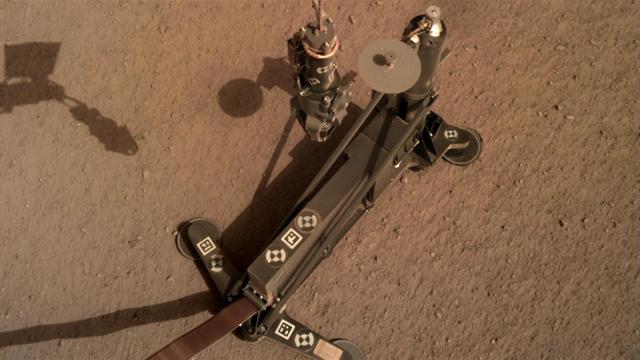The drilling instrument on NASA’s Insight was put through its first test last week, but the inaugural digging session fell far short of expectations due to some potentially problematic rocks directly beneath the Mars lander.
When InSight landed on Mars back in November, we were thrilled that the probe ended up in an area free of large rocks. Less obvious, however, was whether any rocks existed beneath the lander, which would inhibit the probe’s ability to bore down into the Martian surface and gather crucial information about the planet’s temperature.
With a workspace free of major obstructions, the probe managed to deploy two of its primary instruments—the seismometer (aka the marsquake detector) and Heat Flow and Physical Properties Package (HP3), the latter of which was put to work for the first time on February 28, according to the German Aerospace Center (Deutsches Zentrum für Luft- und Raumfahrt, or DLR).
Nicknamed the “Mole,” the HP3 instrument is designed to drill into the Martian surface and, with a special cable equipped with sensors, take temperature readings along the length of the hole. During its first test, the Mole was shown to work, but it now appears that some inopportunely placed subterranean rocks could inhibit further drilling progress.
The Heat Flow probe, developed by DLR and Polish engineering company Astronika, is equipped with a penetrometer – an autonomous, electrically powered hammer that drives itself deeper into the ground with each pulse. A gear stretches its main spring, producing the hammering, forward-thrusting action. A second spring absorbs the recoil.
I’m digging #Mars! My self-hammering mole has started burrowing in, and my team is poring over the data I’ve sent them. They estimate it may be around 35 cm (14 in) down. More hammering to come, as I investigate the inside of Mars.????
More from @DLR_en: https://t.co/FsmfN0WVpa pic.twitter.com/CRHFDp6ouK— NASA InSight (@NASAInSight) March 1, 2019
During the first test of the HP3 system last week, the device managed to drill down to a depth of 13 centimeters (5 inches) before hitting some rocks. Tests on Earth showed the Mole was capable of shoving smaller stones away, but in a process described as “very time-consuming,” according to DLR.
“On its way into the depths, the mole seems to have hit a stone, tilted about 15 degrees and pushed it aside or passed it,” said HP3 principle investigator Tilman Spohn in a DLR press release.
The Mole then encountered another rock at a greater depth and was unable to proceed any deeper; mission planners were forced to stop after the four-hour drilling window expired. By the end of the session — some 4,000 hammer blows later — the Mole managed to drill down to a depth of 50 centimeters (19.5 inches). This, according to the Associated Press, fell far short of expectations.
“This is not very good news for me because although the hammer is proving itself… the Mars environment is not very favourable to us,” Jerzy Grygorczuk, chief engineer of Astronika, told AP.
Another four-hour drilling session should happen soon, but mission planners have to wait for the system to cool down first. The hammering action causes friction, which in turn generates heat; several hours of hammering requires a two-day cooling period. Ideally, as the HP3 experiment proceeds toward the goal of drilling a hole 3 to 5 meters deep, the project will involve a series of four-hour drilling sessions, followed by two-day cooling periods and a day to take temperature readings.
A five-meter long ribbon cable equipped with over a dozen sensors will measure temperature at various depths. Once drilling is complete, the temperature will be measured by all of the sensors at 15-minute intervals for several months. The ultimate goal of the HP3 experiment is to measure changes in heat with depth, and subsequently the heat flow from the interior of the Red Planet.
Mission planners are hoping to conduct more drilling sessions over the next few weeks, but this assumes no impenetrable rocks are lurking below. This would be bad news, as the HP3 system cannot be relocated to another position around the lander. The Mole, as it drills down, is pulling the ribbon cable along with it, and the system is not designed to move or retract in the opposite direction.
So this is a frustrating start to the HP3 phase of the project, in what has otherwise been a spectacularly successful mission to Mars. But we shouldn’t get ahead ourselves—the next drilling session could result in something quite positive.
